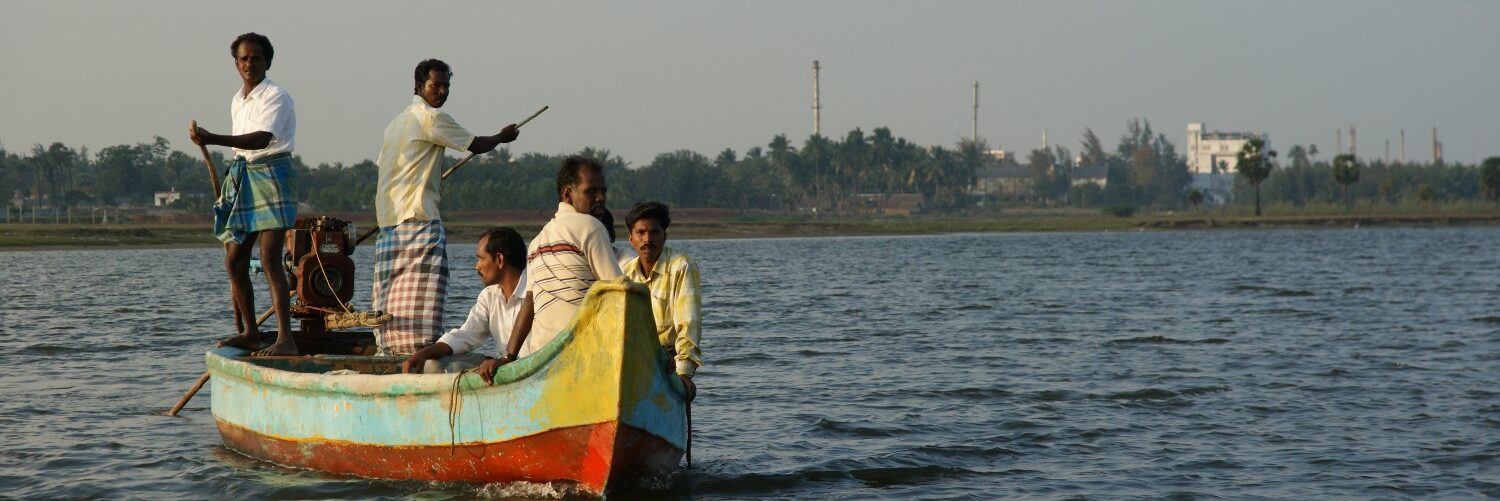Cuddalore, 8 December 2005: Just as life is limping back to normal in the flood-hit areas of Cuddalore and Chennai, yet another “severe depression” — named Fanoos — is poised in the Bay of Bengal southeast of Chennai, threatening to make landfall somewhere between Nagapattinam and Chennai, i.e. Cuddalore. In Cuddalore, AID-India and Cuddalore District Consumer Protection Organisation are liaising with the SIPCOT Area Community Environmental Monitors to distribute relief material to those hardest hit by the floods.
In the vicinity of the SIPCOT Chemical industrial area, Sonnanchavadi and Semmankuppam villages were worst hit. Some houses in Sangolikuppam and Eachangadu were marginally affected. Our relief efforts, therefore, focused on these villages.
Sonnanchavadi registered 100 percent damage. All 90 households were severely damaged or had several feet of standing water inside. Sonnanchavadi is a fishing village, and among the poorest in the region. Many of the huts could not withstand the onslaught of nature’s fury. The families were staying in temporary shelters, in temples, the local school and houses outside that were not severely damaged. Over the last few days, people repaired some of the houses to allow them to return home. However, if Fanoos hits again, the villagers are likely to be out in the water once again. The school, where SACEM workshops are usually held, is totally washed out. This village is likely to require concerted near-term assistance, because most of the families are below-poverty line, and are unlikely to recover anytime soon given that fishing has not returned to normal yet. According to SACEM member and fisherman S. Pugazhenthi, Uppanar river is heavily silted up. As a result, fish catch has dwindled. Those who venture out to fish barely make Rs. 20 for a day’s fishing. “It will take a few weeks after the rains stop for the tide to flush out the silt, and only then will fishing return to normal,” says Pugazhenthi. Less than a year ago, Sonnanchavadi fishermen lost gear and craft to the Tsunami.
In Semmankuppam, a far better-off farming village, many houses had at least 2 feet of water. Farmers have suffered extensive crop damage, and some have lost entire year’s stock of provisions in the water. Nearly 4000 acres of standing crops belonging to Semmankuppam farmers have been destroyed. According to SACEM member S. Ramanathan, the Government has surveyed the crop loss, and there is talk of distribution of compensation of Rs. 8000/acre by the State Government. Also, it is rumoured that on 10 December, interim relief of Rs. 1000 will be distributed.
Relief Distributed
Thanks to contributions from AID-India, AID-Austin, AID-Bay Area and Denny Larson of Global Community Monitor, 1385 packs containing 10 kg rice, 1240 packs of 1-litre cooking oil, and 800 blankets were distributed on a priority basis to those hardest hit.
All 90 families in Sonnanchavadi, including 3 that did not have a ration card, received complete packs containing rice, oil and blankets. In Semmankuppam, 690 kits containing rice, oil and blankets were reached to affected residents from Thachan Colony, Mettu Semmankupam and Semmankuppam village.
In Sangolikuppam, a multi-community village, only 30 huts were affected, and only marginally. However, given that many of the residents here too are at or below poverty level, it was decided to distribute smaller packs — containing 5 kg rice and 1 litre oil — to all 465 households.
In Eachangadu, only rice packets were distributed to 145 households.
Besides those living in the villages, we had identified stray families ostracised by the villages and living in the peripheries. About 10 such families were also given blankets. Rice and other provisions will be delivered in a couple of days.
Eachangadu — 145 families. Only rice.
10 blankets — People outside villages. Monday or Tuesday.
— houses have fallen.
